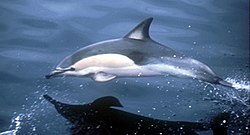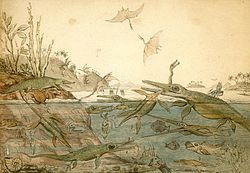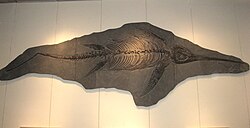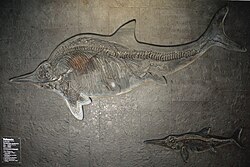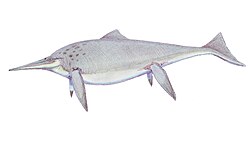
This timeline of ichthyosaur research is a chronological listing of events in the history of paleontology focused on the ichthyosauromorphs, a group of secondarily aquatic marine reptiles whose later members superficially resembled dolphins, sharks, or swordfish. Scientists have documented ichthyosaur fossils at least as far back as the late 17th century. At that time, a scholar named Edward Lhuyd published a book on British fossils that misattributed some ichthyosaur vertebrae to actual fishes; [1] their true nature was not recognized until the 19th century. In 1811, a boy named Joseph Anning discovered the first ichthyosaur fossils that would come to be scientifically recognized as such. [2] His sister, Mary Anning, would later find the rest of its skeleton and would go on to become a respected fossil collector and paleontologist in her own right. [3]
Contents
- 17th century
- 1699
- 19th century
- 1810s
- 1820s
- 1830s
- 1840s
- 1850s
- 1860s
- 1870s
- 1880s
- 1890s
- 20th century
- 1900s
- 1910s
- 1920s
- 1930s
- 1940s
- 1950s
- 1960s
- 1970s
- 1980s
- 1990s
- 21st century
- 2000s
- 2010s
- See also
- Footnotes
- References
- External links
Early researchers recognized ichthyosaurs as marine reptiles, but major aspects of their anatomy and behavior needed to be resolved. They were frequently portrayed as leaving the water to bask on rocks and with straight tails. [4] Although a bend in ichthyosaurs' tail vertebrae was seen from the earliest specimens, scholars assumed the bend reflected damage incurred to the animal's carcass after death. This bend was so common, however, that scholars eventually realized that it was natural and supported a shark-like tail fin. [5] Scientists came to realize that ichthyosaurs were too adapted to leave the water even to lay eggs. Evidence for live birth in ichthyosaurs dates back as far as 1846, when Chaning Pierce reported an apparent fossil Ichthyosaurus embryo to Sir Richard Owen. [6]
Ichthyosaur discoveries continued to be made into the 20th century. In 1928, Simeon Muller discovered the remains of 40 gigantic ichthyosaurs in Nevada. However, these remains would not be excavated until Charles Camp and Samuel Welles of Berkeley led an expedition for the purpose in the mid 1950s. [7] These fossils would take more than a decade to excavate, and the results of Camp's examination of the bones would not be published until a year after his 1975 death. These giant ichthyosaurs were named Shonisaurus popularis and their final resting place is now known as Berlin-Ichthyosaur state park. [8]
Other notable late 20th century advances in ichthyosaur research include the recognition of a new genus of ichthyosaur called Eurhinosaurus longirostris that had been misclassified as a species of Ichthyosaurus since 1854. [9] In 1986 Christopher McGowan would describe another, similar animal serendipitously discovered in England as Excalibosaurus , after King Arthur's mythical sword. [9] The late 1990s and early 21st century would see scholarly debate regarding the cause of the ichthyosaurs' extinction, especially regarding the potential role played by competition with the mosasaurs which had evolved around the time. [10]


